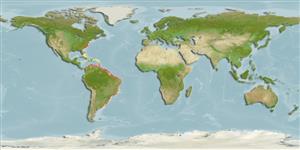Issue
A more detailed taxonomic review of the Eastern versus Western Atlantic M. hypostoma populations is needed to elucidate whether there are population-level differences, or if those differences simply reflect the low sample size available.
Environment: milieu / climate zone / Tiefenbereich / distribution range
Ökologie
seewasser pelagic-neritic; tiefenbereich 0 - 100 m (Ref. 106604). Tropical; 41°N - 40°S, 80°W - 29°W
Western and eastern Atlantic.
Size / Gewicht / Alter
Geschlechtsreife: Lm ? range ? - ? cm
Max length : 230 cm WD Männchen/unbestimmt; (Ref. 126011); max. veröff. Gewicht: 115.9 kg (Ref. 126011)
Cephalic fins smaller, tail longer without spine (Ref. 7251). Upper surface black (Ref. 6902).
Body shape (shape guide): other.
Occurs in shallow coastal waters (Ref. 12951). Feeds mainly on planktonic crustaceans but may take small schooling fishes (Ref. 12951). Ovoviviparous (Ref. 50449). Found singly, in small groups, and in schools (Ref. 12951). Swimming at high speed and often leap high above the surface (Ref. 6902). Feeds mainly on planktonic crustaceans, but also on small schooling fishes (Ref. 114953). Meat used for food and a source of oil (Ref. 6902).
Life cycle and mating behavior
Geschlechtsreife | Fortpflanzung | Ablaichen | Eier | Fecundity | Larven
Exhibit ovoviparity (aplacental viviparity), with embryos feeding initially on yolk, then receiving additional nourishment from the mother by indirect absorption of uterine fluid enriched with mucus, fat or protein through specialised structures (Ref. 50449). Copulation has been observed to be in a venter to venter position while the pair swims at the surface. Mating reported to last 10 minutes. Litter number 1 (Ref. 12951).
White, W.T., S. Corrigan, L. Yang, A.C. Henderson, A.L. Bazinet, D.L. Swofford and G.J.P. Naylor, 2018. Phylogeny of the manta and devilrays (Chondrichthyes: Mobulidae), with an updated taxonomic arrangement for the family. Zool. J. of the Linn. Soc., 20:1-26; figs. (Ref. 115945)
IUCN Rote Liste Status (Ref. 130435: Version 2025-1)
Bedrohung für Menschen
Harmless
Nutzung durch Menschen
Fischereien: weniger kommerziell
Tools
Zusatzinformationen
Download XML
Internet Quellen
Estimates based on models
Preferred temperature (Ref.
123201): 13.7 - 27.7, mean 23.2 °C (based on 232 cells).
Phylogenetic diversity index (Ref.
82804): PD
50 = 0.5039 [Uniqueness, from 0.5 = low to 2.0 = high].
Bayesian length-weight: a=0.01000 (0.00244 - 0.04107), b=3.04 (2.81 - 3.27), in cm total length, based on all LWR estimates for this body shape (Ref.
93245).
Trophic level (Ref.
69278): 3.8 ±0.59 se; based on food items.
Widerstandsfähigkeit (Ref.
120179): sehr niedrig, Verdopplung der Population dauert mehr als 14 Jahre. (Fec=1).
Fishing Vulnerability (Ref.
59153): Very high vulnerability (84 of 100).
🛈
